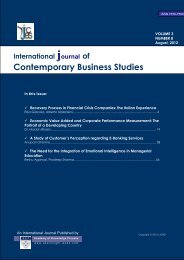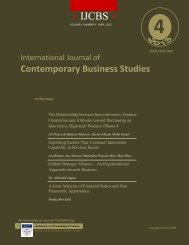Contemporary Business Studies - Academy of Knowledge Process ...
Contemporary Business Studies - Academy of Knowledge Process ...
Contemporary Business Studies - Academy of Knowledge Process ...
You also want an ePaper? Increase the reach of your titles
YUMPU automatically turns print PDFs into web optimized ePapers that Google loves.
International Journal <strong>of</strong> <strong>Contemporary</strong> <strong>Business</strong> <strong>Studies</strong>Vol: 4, No: 2. February, 2013 ISSN 2156-7506Available online at http://www.akpinsight.webs.comExternal employability refers to the ability and willingness to switch to a similar or another job in anotherfirm, and therefore reflects the value <strong>of</strong> the workers’ within the realm <strong>of</strong> human capital in the externallabor market. For instance, employees who are able to switch to a similar job in another firm, must bewilling to work in another firm provided that he/she will perform a similar job or will not have anyproblems doing a different job in another firm, being confident that with the skills, knowledge andexperiences or confident that he/ she is employable in another firm are considered as having externalemployability.Internal employability refers to a worker’s ability and his willingness to remain employed with the currentemployer, which is the value <strong>of</strong> a worker’s human capital in the internal labour market. Trainedemployees can be employed within the firm with less supervision. Employees can multi-tasks within thedepartment or firm or relocated/reassigned to different department to perform tasks whereby they becomeemployable to perform different tasks within the firm. Internal employability rate further improves theircareer path as they come prepared with the right skills, education level and qualifications to enhance theirworking career. The idea <strong>of</strong> employability is <strong>of</strong> concern nowadays with the uncertain economic situationthat exposes both the employers and employees to various ambiguities. Employees who are less skilledand competent are susceptible to retrenchment. Employers have to juggle between the need to containcost and maintain productivity to ensure efficiency. Having only the right people with the right skills atthe right time is their priority. Thus, employees should have marketable skills that ensure them apromising career ahead.The changes made in today’s organizational context do not only result in the erosion <strong>of</strong> job security andthe transfer <strong>of</strong> career-management responsibilities that concerns employability, there is also a change inthe definition <strong>of</strong> career success itself. According to Baruch (2004), one’s career success was traditionallybased on hierarchical, highly structured, and rigid structures, thus it has a clear linear direction <strong>of</strong>prescribed prospects or promotion. In today’s volatile environment however, the nature and notion <strong>of</strong>careers have changed as people now experience different ways <strong>of</strong> defining career success, for instance, itcould be a sideway move, change <strong>of</strong> direction, <strong>of</strong> organization and <strong>of</strong> aspiration (Baruch, 2004).Finally, with the resurgence <strong>of</strong> employability issues in the business environment, more detailedexploratory study is needed to address the issues <strong>of</strong> career and employment in this area. For instance,according to Steward and Knowles (2000), the main motive for students to attend university is no longerto study a particular subject in depth but instead to enhance their employment prospects.In total, thechanges taking place economically and the likelihood <strong>of</strong> recognizing career self-management will muchdetermine success <strong>of</strong> individual’s employability. However, despite its widespread use across both theacademicand popular management literature, what exactly constructs employability remainselusive(Clarke and Patrickson, 2008), thus setting a very ambiguous and dynamicworking environment.2.0 LITERATURE REVIEW2.1 EmployabilityEmployability has been in the spotlight since the 1990s (Forrier&Sels, 2003), but the historicalantecedents <strong>of</strong> the current debate can be traced back almost a century (see Gazier, 1998; McQuaid&Lindsay, 2005). Employability has been conceptualized from three different perspectives, the economicsocial,the individual, and the organizational (Van Dam, Van der Heijden, &Schyns, 2006). Within theeconomic-social perspective, employability refers to the ability <strong>of</strong> different categories <strong>of</strong> the labour forceto gain and maintain employment (Finn, 2000). This perspective distinguishes between the employableand the unemployable (McQuaid& Lindsay, 2005), a distinction that is closely related to governmental2013©<strong>Academy</strong> <strong>of</strong> <strong>Knowledge</strong> <strong>Process</strong>7
















